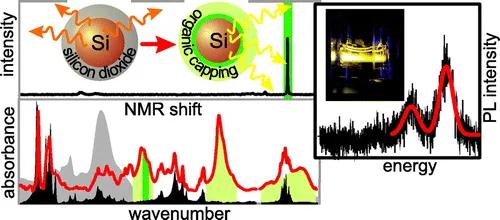Silicon nanocrystals are an extensively studied light-emitting material due to their inherent biocompatibility and compatibility with silicon-based technology. Although they might seem to fall behind their rival, namely, direct band gap based semiconductor nanocrystals, when it comes to the emission of light, room for improvement still lies in the exploitation of various surface passivations. In this paper, we report on an original way, taking place at room temperature and ambient pressure, to replace the silicon oxide shell of luminescent Si nanocrystals with capping involving organic residues. The modification of surface passivation is evidenced by both Fourier transform infrared spectroscopy and nuclear magnetic resonance measurements. In addition, single-nanocrystal spectroscopy reveals the occurrence of a systematic fine structure in the emission single spectra, which is connected with an intrinsic property of small nanocrystals since a very similar structure has recently been observed in specially passivated semiconductor CdZnSe nanoparticles. The organic capping also dramatically changes optical properties of Si nanocrystals (resulting ensemble photoluminescence quantum efficiency 20%, does not deteriorate, radiative lifetime 10 ns at 550 nm at room temperature). Optically clear colloidal dispersion of these nanocrystals thus exhibits properties fully comparable with direct band gap semiconductor nanoparticles.
Our team proposed the main idea. We introduced and realized an original technology of preparing samples, experimentally acquired ensemble photoluminescence emission and excitation spectra and luminescence kinetics; we also discussed and interpreted the results. Co-authors outside our institution contributed by applying single-nanocrystal spectroscopy and performing NMR, FTIR, STM and dynamic light-scattering measurements.
